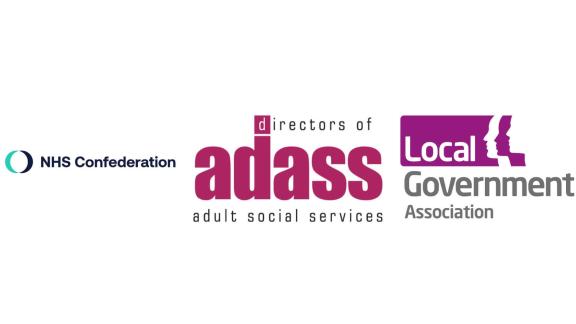What our joint vision means for people and communities this winter

Alongside the Association of Directors of Adult Social Services and Local Government Association, we have set out a vision for a high-quality and sustainable health and care system. Here we explore what it means in the current context of intense pressures across the system.
Maximising health and wellbeing and preventing or delaying people developing health and care needs
We are facing the most challenging winter ever for all parts of the social care and health system – from community and voluntary sector organisations to residential and home care, and hospitals and ambulance trusts. The growing demographic, cost of living, workforce and inflationary pressures facing all parts of health and care are too big to be addressed through better coordination or finding yet more efficiency savings.
Short-term funding arrangements may fend off immediate crises but they do not allow for longer-term remodelling of care and support
All of our organisations have put forward strong and detailed cases for immediate financial support to shore up fragile health and care services to get us through the winter. We have also called for certainty of funding over the next three to five years so that local care and health leaders can invest in new models of care and support which focus on maximising wellbeing, resilience and independence. Short-term funding arrangements may fend off immediate crises but they do not allow for longer-term remodelling of care and support. It just perpetuates and prolongs the crisis.
Furthermore, our care and support model needs to extend to people in the most difficult circumstances, particularly people who lack capacity and may need safeguarding support.
The government needs to trust and support local leaders and communities across the NHS, local government and the community and voluntary sector to change the model of care and to invest more in prevention and community-based support
We understand and support the government and NHS England focus on getting people out of hospital when they are well enough to go home with the right support to enable them to fully recover. However, we also need to prevent them being admitted in the first place. We need much greater emphasis on, and investment in, the kind of support people want to be safe and independent at home, with rapid treatment or crisis support if needed. Investing in home and community support is better for people, but it is also a far better use of taxpayers’ money than in-patient care.
The government needs to trust and support local leaders and communities across the NHS, local government and the community and voluntary sector to change the model of care and to invest more in prevention and community-based support. They know their communities best. Public health and prevention are crucial here, as primary health services, adult social care and the community and voluntary sector can get to people earlier and prevent them deteriorating in order to avoid unnecessary periods in hospital.
It is imperative that local leaders have the flexibility and resources to invest in and shape community and social infrastructure which contribute to community resilience
A key purpose of integrated care systems (ICS) is to support broader social and economic development, contributing to wider ambitions for systems and places. This is a welcome recognition that our NHS cannot, on its own, turn the curve of growing ill health and long-term conditions and that they must work with councils, business, housing, the police and criminal justice system and the wider public sector. It also means working with our communities and focusing on the social issues that affect their health and wellbeing.
Giving children the best start in life, safe and affordable homes for all, education and training to get good jobs, communities that look out for each other, are safe and actively promote participation and healthy behaviours, and protection from environmental harms are all vital to improving health outcomes. It is imperative that local leaders have the flexibility and resources to invest in and shape community and social infrastructure which contribute to community resilience.
Working together on a recovery model to regain health and independence
People will always need hospital care and, as health and care partners, we will strive to ensure that they have access to high-quality and effective hospital care. But we also need to develop more effective ways of keeping people out of hospital. That means investing in much more home and community support. In addition, we support a recovery approach which enables people to get back to being themselves and living the lives independently after a period of hospital care. It includes reablement, rehabilitation and intermediate care.
We need implementation funding that go beyond test and pilot initiatives to ensure new models are mainstreamed and sustainable
Across social care, health and the community and voluntary sector we are developing models of health and care that best deliver for people but we need long-term resources to invest in new models. The government’s agenda for reform across health and care already points to many such new models of delivery, but without corresponding funding they will forever remain an aspiration. We need implementation funding that go beyond test and pilot initiatives to ensure new models are mainstreamed and sustainable.
The recovery approach requires all services and professionals across adult social care, the NHS, housing and the community and voluntary sector to plan and deliver care and support that is appropriate to each person’s needs and wishes and capacities so that they can recover their independence.
Local partners need the freedom and flexibility to develop effective and appropriate recovery models for their communities
Though a core element of recovery is quick and timely discharge from hospital in order to free up hospitals for people who need them more, this is not the primary aim. The primary aim is to achieve the best possible outcome for people, maximising their confidence and independence and wherever possible, enabling them to return to their own homes. The recovery approach also supports people to remain in their own homes by early intervention to reduce future unplanned hospital admissions. The support services for people on discharge from hospital are no different to the services and support that can prevent them being admitted in the first place.
Core components of the recovery model are:
- prevention, including crisis support – first and foremost, to identify people at risk of admission and to put in place care and support, including crisis support, to prevent them need hospital treatment
- discharge planning – NHS and social care to plan appropriate discharge support on day one of admission, with involvement of the community and voluntary sector and housing providers
- multi-disciplinary teams – including adult social care, NHS community health professionals, the community and voluntary sector, housing and mental health services
- timely, shared and trusted data – all commissioners and providers across health, care and the voluntary and community sector to contribute and have access to a shared data set to enable them to have a ‘single version of the truth’
- rapid review – adult social care and NHS staff jointly review all people being discharged from hospital to make sure that they have the information to make informed choices about the risks and benefits of different options and ensure that any ongoing treatment, care and support is appropriate, with the aim of regaining independence, confidence and connectedness
- support for informed choices – whether in hospital, in a temporary residential setting or at home, everyone should be the information, time and support in order to make informed choices about their care and housing support in the future
- going home with support – including primary care, community mental health services, domiciliary and community and voluntary sector support with an agreed date for rapid review to assess any ongoing health and care needs
- bed-based intermediate support in residential care homes – for a limited period with an agreed recovery, rehabilitation and reablement plan to ensure that care and support is focused on helping people to return to their own homes or make decisions about longer term care options
- more investment in diverse models of care – including Shared Lives, carers support, ‘floating support‘ and supported employment as effective models of care and support to maximise independence at home
- more investment in a range of housing options, including supported accommodation – for people who are unable to return to their own homes, to enable them to live in different housing within their communities with the appropriate level of support.
This must be planned and delivered in partnership with local communities, the NHS and local government, through existing integrated care partnerships and existing governance structures, for example the Better Care Fund led and overseen by place-based health and wellbeing boards.
Local partners need the freedom and flexibility to develop effective and appropriate recovery models for their communities. They also need sufficient funding from government to support adult social care, public health, the NHS and the community and the voluntary sector.
Effective, sustainable and high-quality care and support for people who need it
Our three organisations agree on the core components that are essential to all health and social care services for people who need our support:
- our people our our biggest asset
- person-centred and co-produced
- outcomes-focused.
Our people are our biggest asset
The paid and unpaid workforce across the public, private and voluntary and community sectors are the lifeblood of our health and care services. They are all vital and their dedication and commitment is mutually reinforcing across all parts of the health and social care sector. Parity of esteem across the social care and health sectors and between paid and unpaid carers is essential if we are to best deliver for our country and our communities.
We are facing an unprecedented and severe recruitment and retention crisis across the health, social care and the community and voluntary sector. People are leaving the sector because they can earn more working in retail or the leisure sectors. And the lack of staff means that many people are waiting longer for hospital treatment, NHS community services and social care, whilst others are admitted to hospital because there are no community services to support them. Equally, people who wish to recruit personal assistants are unable to do so.
We need to ensure that unpaid carers are supported to continue providing vital support. Without unpaid carers social care and health services would collapse. Unpaid carers have been hit particularly hard hit by the cost-of-living crisis and need urgent support to avoid breaking down.
Person-centred and co-produced
People who draw on health and social care support know best what works for them. The most effective way of designing and delivery care and support is to do so in partnership with people with lived experience. We have a strong base to build on. The ‘Making It Real’ framework developed by Think Local Act Personal (TLAP) remains the sector benchmark for articulating in practical terms what good, personalised and community-based support looks like from the perspective of people who use services and supports.
It also helps to capture and define the essence of wellbeing and prevention by thinking of health and social care support not as a reactive response to need but as a force for creating supportive and inclusive places for people to live. In this way, housing, open spaces, public health, transport, wider public and voluntary sector services all have a role to play in improving people’s wellbeing and independence in each local area.
Outcomes-focused
The national political focus on constant firefighting to reduce trolley waits, deal with delayed discharges and clear bed space in acute hospitals is a narrow and short-sighted approach. The focus needs to shift to the wider health and care services and supports. The Government must enable local leaders to change their focus to achieving the best outcomes for people, rather than meeting national targets for performance and activity, which tends to focus on capacity in acute hospitals. This must be about people and outcomes, not building and processes.
Care and support, including acute care is vital, but we need to shift the emphasis onto ensuring that people can access the right care, in the right place, at the right time. For most people, most of the time that is at home.
Final thoughts – the essential components of a sustainable health and care
The care and support model we propose above is achievable if we have adequate, long-term funding and certainty. Integrated care systems and the continuing work of place based partnerships provide a collaborative model of leadership that can drive forward preventative and person-centred approaches.
In addition to money, there are four other key components necessary to our shared model and vision:
- let local leaders lead – give them the freedom to co-produce their own priorities for improving population health with local communities, with the focus on building from the bottom up
- our people are our most valuable asset – we need to plan, protect and promote the workforce
- give us certainty to plan new models of care and support – a long-term funding settlement across health, social care and local government
- recognise health and care sectors as major economic assets that require funding to reap returns – such funding is not about fixing a problem, but about investing in all of our futures.


